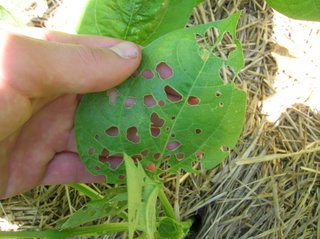Mexican Bean Beetle
Mexican Bean Beetle
The damage shown in this first picture is the characteristic pattern of destruction caused by the mexican bean beetle. I first noticed the damage in early may on the first "new" leaves of the bush string bean plants.
The damage shown in this first picture is the characteristic pattern of destruction caused by the mexican bean beetle. I first noticed the damage in early may on the first "new" leaves of the bush string bean plants.
 The beetle, Epilachna varivestis Mulsant, is said to be native to the south of mexico but seems to be a problem over much of the US now (based on the fact that alot of agriculture extension services have information about controling this pest). You can see in the picutre below that the beetle looks a lot like its close relative the ladybug. They are both in the order Coleoptera and the family Caccinellidae. The beetle shown here looks slightly different than the ones usually found on the plants in my garden, which have a brighter, almost pink color.
The beetle, Epilachna varivestis Mulsant, is said to be native to the south of mexico but seems to be a problem over much of the US now (based on the fact that alot of agriculture extension services have information about controling this pest). You can see in the picutre below that the beetle looks a lot like its close relative the ladybug. They are both in the order Coleoptera and the family Caccinellidae. The beetle shown here looks slightly different than the ones usually found on the plants in my garden, which have a brighter, almost pink color.
Shown below is a adult beetle and its larve. The larva found on the plant in my garden have darker spines, but I have read that that is normal variation. Both the adult and the larva will feed on the leaves and the stems of the plant but most of the damage is done to the leaves. The larva is supposed to be a much more aggressive feeder than the adult.

Prevention:
I really don't know any good prevention methods yet. I need to do some research on the ATTRA web site about this. I think certain varieties are more attractive than others. Soybeans seem to be resistant.
Control:
Luckily these beetles are susceptible to the organic insecticide pyrethrin. Pyrethrin is derived from chrysanthemum cinerariaefolium plant. It is a general toxin but very safe to apply. I don't know its effect on the good insects, but it works effectively and rapidly to reduce damage by the mexican bean beetle. Multiple applications may be needed.

0 Comments:
Post a Comment
<< Home